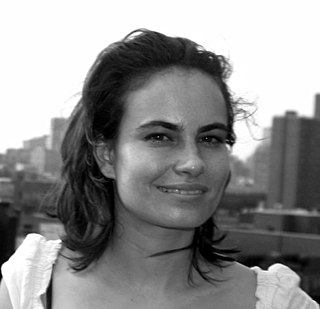Dana Schutz is an American artist who lives and works in Brooklyn, New York. Schutz is known for her gestural, figurative paintings that often take on specific subjects or narrative situations as a point of departure.

Inka Essenhigh is an American painter based in New York City. Throughout her career, Essenhigh has had solo exhibitions at galleries such as Deitch Projects, Mary Boone Gallery, 303 Gallery, Stefan Stux Gallery, and Jacob Lewis Gallery in New York, Kotaro Nukaga, Tomio Koyama Gallery in Tokyo, and Il Capricorno in Venice.

Yvonne Helene Jacquette was an American painter, printmaker, and educator. She was known in particular for her depictions of aerial landscapes, especially her low-altitude and oblique aerial views of cities or towns, often painted using a distinctive, pointillistic technique. Through her marriage with Rudy Burckhardt, she was a member of the Burckhardt family by marriage. Her son is Tom Burckhardt.

Emma Amos was a postmodern African-American painter and printmaker.

Diane Burko is an American painter and photographer. She is currently based in Philadelphia and Bucks County, Pennsylvania. Her work addresses landscape, climate change and environmental activism.

Amy Pleasant is an American painter living and working in Birmingham, AL.

Bobbi Mastrangelo (1937-) is an artist specializing in relief sculpture, mixed media, and fiber art including handmade cast paper. She was born Barbara Ann Betschen on May 16, 1937 in Youngstown, Ohio. Her work is best known for its unusual focus on the theme of manhole covers and water covers, grates and drains. Her art has been exhibited widely throughout the United States and is in the collections in several museums.

Mary Miss is an American artist and designer. Her work has crossed boundaries between architecture, landscape architecture, engineering and urban design. Her installations are collaborative in nature: she has worked with scientists, historians, designers, and public administrators. She is primarily interested in how to engage the public in decoding their surrounding environment.

Polly E. Apfelbaum is an American contemporary visual artist, who is primarily known for her colorful drawings, sculptures, and fabric floor pieces, which she refers to as "fallen paintings". She currently lives and works in New York City, New York.
Tauba Auerbach is a visual artist working in many disciplines including painting, artists' books, sculpture, and weaving who lives and works in New York.
Laylah Ali (born 1968) is an American contemporary visual artist. She is known for paintings in which ambiguous race relations are depicted with a graphic clarity and cartoon strip format. She lives in Williamstown, Massachusetts, and is a professor at Williams College.

Hermine Freed, was an American painter, photographer, and video artist. She is noted for being among the first generation of artists to explore video art in the late 1960s.

LaToya Ruby Frazier is an American artist.
Dawn Clements (1958–2018) was an American contemporary artist and educator. She was known for her large scale, panoramic drawings of interiors that were created with many different materials in a collage-style. Her primary mediums were sumi ink and ballpoint pen on small to large scale paper panels. In order to complete a drawing she cut and pasted paper, editing and expanding the composition to achieve the desired scale. Her completed drawings reveal her working process through the wrinkles and folds evident in the paper. She described her work as "a kind of visual diary of what [she] see[s], touch[es], and desire[s]. As I move between the mundane empirical spaces of my apartment and studio, and the glamorous fictions of movies, apparently seamless environments are disturbed through ever-shifting points of view."
Lucy Fradkin is an American self-taught artist from New York who paints portraits which often include collage elements. She is inspired by Persian and Indian miniature paintings with bright palettes and flattened space as well as the ancient frescoes and mosaics of Etruria, Rome, and Byzantium. In addition, she visited the Brooklyn Museum as a young artist with her mother and was inspired by The Dinner Party by Judy Chicago, as a prominent piece of art by a living woman artist.

Kambui Olujimi is a New York-based visual artist working across disciplines using installation, photography, performance, tapestry, works on paper, video, large sculptures and painting. His artwork reflects on public discourse, mythology, historical narrative, social practices, exchange, mediated cultures, resilience and autonomy.
Ann Pibal is an American painter who makes geometric compositions using acrylic paint on aluminum panel. The geometric intensity is one of the key characteristics that defines her paintings.

Tomashi Jackson is an American multimedia artist working across painting, video, textiles and sculpture. Jackson was born in Houston, Texas, raised in Los Angeles, and currently lives and works in New York, NY and Cambridge, MA. Jackson was named a 2019 Whitney Biennial participating artist. Jackson also serves on the faculty for sculpture at Rhode Island School of Design. Her work is included in the collection of MOCA Los Angeles. In 2004, a 20-foot-high by 80-foot-long mural by Jackson entitled Evolution of a Community was unveiled in the Los Angeles neighborhood of West Adams.

Vivian Springford (1913–2003) was an American painter and assemblage artist active in the second half of the 20th century. Springford's abstract paintings and collages are best known for their focus on using color to express captivating patterns and phenomena found in nature as well as from Chinese Calligraphy and Eastern forms of thought such as Taoism and Confucianism.
James Little is an American painter and curator. He is known for his works of geometric abstraction which are often imbued with exuberant color. He has been based in New York City.













